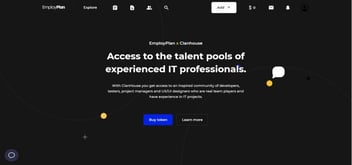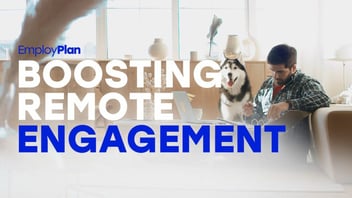
I'm really pleased to announce the next version of EmployPlan is complete! The team in Poland has been working extremely hard to leap forward in functionality and we hope you like what we have built. In this blog post, we will cover some of the new features, as well as talk about some features and new services coming in the next 45 days as we rapidly innovate on the platform.
We introduced a lot of changes to the functionality of the platform and the user experience, including new integrations, new AI capabilities and new user experiences. Let's go through them!What is EmployPlan?
EmployPlan is a cloud service that empowers professional services companies to manage projects more effectively by aligning the right talent with the right tasks. It provides tools for skill assessment, resource planning, and team management, enabling companies to optimize workforce utilization and improve project outcomes. With features like detailed skill mapping, real-time resource allocation, and instant assignments of training and mentoring while integrating into your existing toolsets for managing tasks and time, EmployPlan helps companies ensure that each project is staffed with the most suitable team members, reducing inefficiencies and enhancing overall project success.
Integrating with Task and Time Systems
Core to the project management approach that most professional services companies take is build a system, such as Jira, Asana or ServiceNow, to manage the assignment of tasks and project work to specific resources. We saw an opportunity to increase the automation between EmployPlan and these systems, so we have built integrations, starting with Jira, that connect them to Employplan to automate the process of ingesting prior tickets to build the skill and experience profiles of the resources in your team, as well as automatically reassigning open tickets to new resources when they are brought into a project as a change of role so that tasks in the project do not get orphaned. Asana is next on deck for integration, but we are actively polling our customers to get insights on the most critical platforms.
Next, we integrated with time management systems, starting with Clockify, but adding others quickly now that the core functionality is complete. As with Jira, we pull the history to build a profile of how much time people have billed against specific roles, skills and task types to build the experience profile for your team. Additionally, we push changes to the timecard system based on who is assigned to the project, ensuring that resources cannot mistakenly claim time against a project they are not assigned to. This gives you greater control over the financial side of your projects and ensures clean billing events in the course of staff changes in a product. On our short list is Tempo next, followed by others our customer's request.
Accelerating with AI and new matching algorithms
Large Language Models in AI platforms, like ChatGPT, Cohere or Anthropic are a major breakthrough in technical capabilities, but we wanted to approach using AI in a way that is designed to be helpful and convenient, not intrusive or disruptive. We adopted the principle of "AI is an option, not a speedbump" - noting the principle that AI should accelerate your task outcomes, not complicate them or produce less reliable results than the human would. One example of how we are using it is in the project builder:

In this approach, you can just start building your team by giving a role, level and context to help guide the system to look across your established professions and roles to create the initial team, or you can build the team with our stepper role by role. In each case, you have control over things like phases assigned to, billing rates by resource, skills required and time committed, but building large projects with duplicate roles are much easier with the AI builder.
We also use AI as a processor to ingest user profiles from Linkedin and other sources they identify, making it simpler and more accurate for us to get an idea of their skills, certifications and experiences from prior to their current job. This helps automate the profile building in a material way, accelerating the richness of the profile for project matching.
We will continue to use AI in a thoughtful way to accelerate the work of project management while remaining 'helpfully unobstrusive' versus creating a model where AI is a barrier to task completion.
Our matching algorithm has been significantly improved as well, introducing new models that allow you to choose between economic fit vs. skill and experience fit. This is done in an intuitive model that was based on the process of creating the perfect team from the models in RPG video games - choosing between recommendations and making tradeoffs in a very easy to understand user interface that I'll describe below the image.
 In this view, you can see a couple of controls that are new - a lock icon for each role, alternatives for each role and information about their relative costs, time availability match and skill match.
In this view, you can see a couple of controls that are new - a lock icon for each role, alternatives for each role and information about their relative costs, time availability match and skill match.
The most interesting part is at the top, however, which allows you to choose between economic fit (typically less experienced in a skill) and expertise fit (may be quicker, but more costly). When this first comes up, if you slide the bar left or right, it changes the recommended resources for the allocated roles on the team. Once you lock a resource, it's locked to the team (unless you unlock it, of course) and you can change the goal of the matching algorithms by changing the slider and then rerolling the team selection.
Practically, this allows you to search for critical experts for core project roles, lock them, then sort on economics or balanced or any point in between on the scale. The algorithms aren't linear, but exponential - a small shift off the center introduces a relatively small change, but moving more aggressively to the outside of the scale aggressively changes the algorithm. With this new functionality, you can explore tradeoffs with your project leads to make sure critical client needs and project dependencies have the talent you need and the project has the economics you want.
New User Experience improvements
There are too many discrete changes here to list them all, but I wanted to focus in on just some work we have been doing to make the whole platform more usable for more roles outside of the classic resource manager role. First up is the Action Center - A place that shows you all open issues, errors or concerns with projects, people or finance so you can close all issues before pushing the project to live. For each user, they will have a task list that both reminds them of tasks, but also lets them complete them within that interface.

Next, we put actionability into many places. Want to see alternatives the algo is recommending for a given role or see their profile? Simply hover over the allocation card in the Project Chessboard and see alternatives you can select or details on gaps in a panel on the right where you can quickly take action, such as assigning training to close a skill gap or assigning a mentor to close an experience gap for a project. This 'instant actionability' is now broadly throughout the platform.

There is so much more to show you and we will in subsequent blog posts, but I encourage you to check out what we have built - there are hundreds of improvements in the past 3 months to share with you.
A new economic model
One of the things I wanted to change when I joined EmployPlan as an investor and operator was to innovate more on the e-commerce side of things. One thing I realized as in investor in tech companies is how complacency drives poor customer experiences - the constant innovation is being driven by the needs of the next "big deal" coming in the door, versus the existing customer base, leading to an overfocus on features that may not appeal to your loyal customers.
One way to do that is to make every contract auto-terminating every month and to set the payment model in arrears - let's go through what that means in a little more detail:
Auto-terminating means that you don't need to ever call us to cancel or fight through some labyrinthian customer support process to cancel your service - if you want to cancel, simply remove your payment method as our bills are processed in arrears - at the end of the month of service, not the start, creating a condition where we have to re-earn your business and, at any time a bill is processed, you have an entire month of usage and if you cancel at the end of the month before the bill is processed (you get a notification before all processing every month), you pay nothing for that month.
Second, for our new launch, we are moving to a flat per-user price of $10/month for all features. Eventually, we have some modules and features planned that will be extra, as they will appeal to specific new use cases or new user types, like learning managers and financial managers, but generally we are pricing this to make it easier to adopt across larger organizations and practices.
Overall, I am super proud of the team and the work they have done, delivering hundreds of improvements and architectural capabilities in a few short months. I hope you find it valuable and it helps you accelerate your services business to even more profitability and growth.


